A Scene of Her Own: The Inimitable Vaginal Davis
Her blond hair perfectly flipped, a smile breaking across her warm and open face, Vaginal Davis takes the mic, satin blue nighty shimmying. Amidst a stage of fierce femmes of…
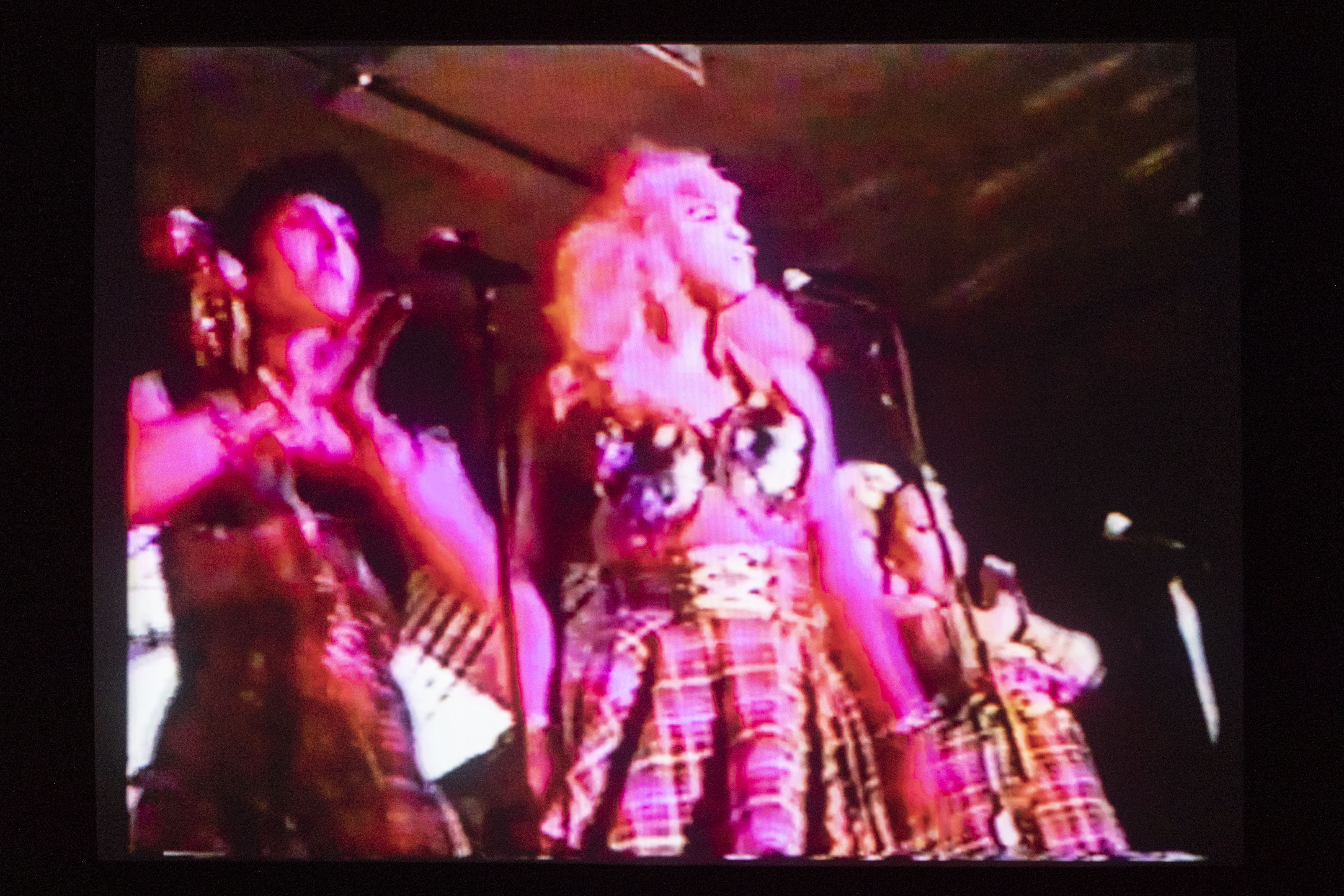
Her blond hair perfectly flipped, a smile breaking across her warm and open face, Vaginal Davis takes the mic, satin blue nighty shimmying. Amidst a stage of fierce femmes of all shapes and sizes rocking back and forth in slumber party attire, Davis holds the center of our attention. Performing tonight as Graciela Grejalva—lead singer of Cholita!—she sings, she shouts, sweating, spitting rapid-fire lyrics, a pink swatch of fabric clutched in one hand. Her other hand gesticulates wildly, mirrored by the lingerie-clad woman to her left who cajoles in pantomime, pointing at, sometimes flipping off the audience, implicating and drawing them in. Black and brown women, including Alice Bag of Sad Girl and The Bags, play backup to our Blatino (half Black, half Mexican), intersexed, queer drag superstar, churning out a low-fi frenzied garage punk beat. “CHINGA TU, CHINGA TU, CHINGA TU MADRE!” they collectively sing in urgent, joyful unison. Go fuck yourself. Literally, go fuck your mother.
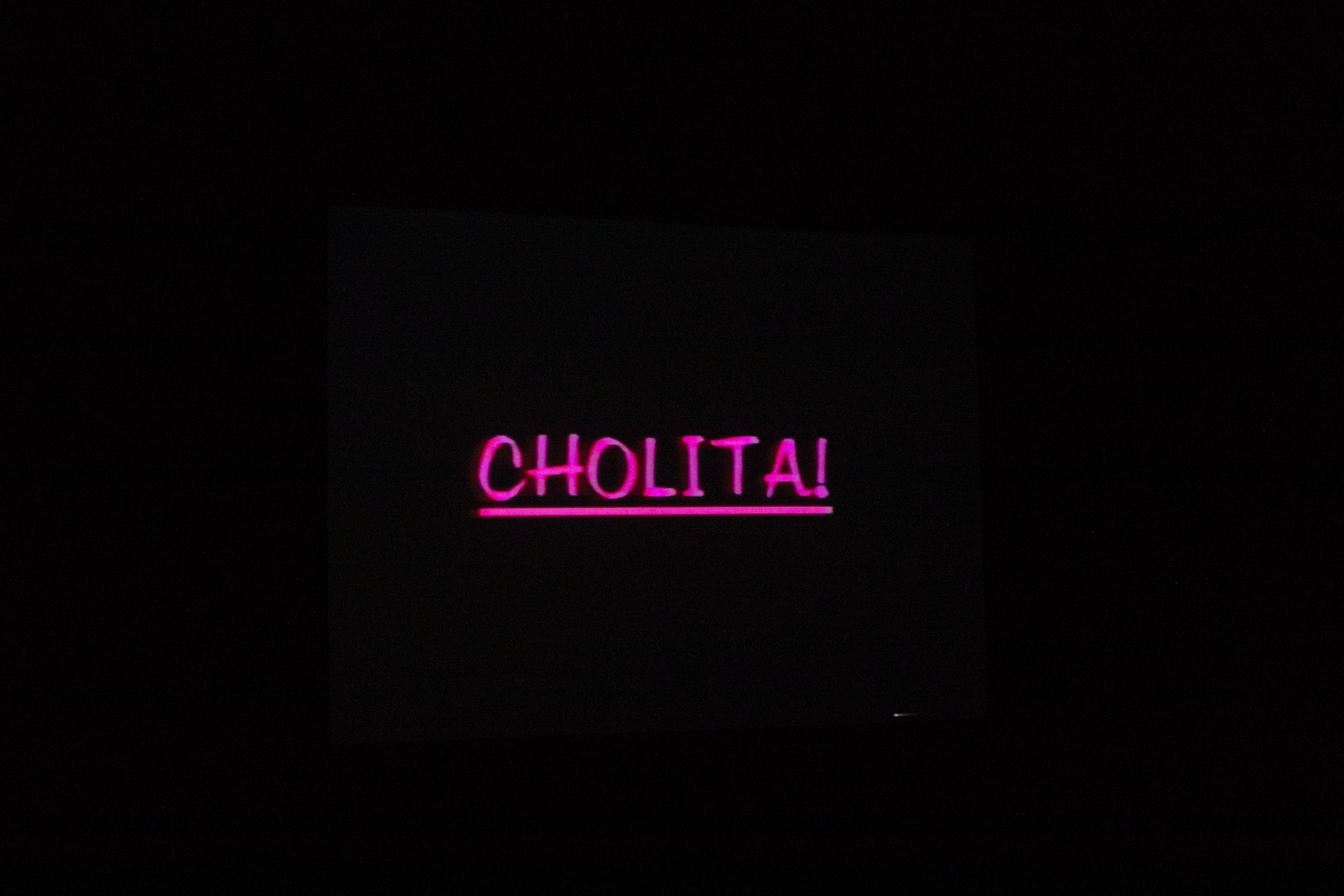
Vaginal Davis, who named herself after Black radical Angela Davis with a queer, humorous twist, is not here to entertain you. Her work, which includes writing, independent video, public access programming, bar drag, music, sculpture, theatre, performance art, and nightlife hosting, has been lasting and life-sustaining. Her influence has spanned decades, inspiring countless cultural interventions in queer life and beyond.
The scene I open with appears in the 1995 video footage of Cholita!, one of Davis’s “multiracial, maxi-gendered” bands constructing and performing what is, to my mind, a “biomythography,” a term Black feminist lesbian poet Audre Lorde created in the early 1980s to describe a mix of biography, myth, and history. Davis is an invention of her own making, a bricoleur, an inimitable force of irreverent brilliance evident in all her performances and print media (primarily zines such as the infamous Fertile La Toyah Jackson (1982-1991)). She resides now in Berlin but came up in late 1970s Los Angeles, establishing herself quickly as a legendary punk fixture central to the performance, video art, and homocore/queercore scenes that merged punk aesthetics with queer content. In addition to Cholita! (“The Female Menudo”), her underground bands included Pedro, Muriel, and Esther (PME), Black Fag (a satirical send-up of famed California punk band Black Flag), and Afro Sisters consisting of Davis and two white women backup singers sporting Afros.
As this Cholita! performance establishes clearly, Vaginal Davis is here to enjoy herself, often at our expense, in the most generous and playful way imaginable. But when I say “play” I mean serious play or what Davis calls “crazy fun.” Blistering critique. Uncomfortable irony. Black humor. She pauses, cheekily, inviting the audience to a call and response. “Let me say it and then you say it!” “LISTEN!” she implores the audience giddily laughing over her. “CHINGA TU…” she enunciates slowly, followed by “GoooOOOD!”, a single syllable word stretched to five syllables with such sincere rising enthusiasm one cannot help but want to be caught up in anything, in everything Davis is doing. Young queers, femmes, PoC punks, she’s hailing us. “You can sing along with us” she promises, but “CHINGA ME?! NO. CHINGA TU” just in case you forget who created this scene, who invited you in. There is no mistaking who is fabulously in charge here. Davis demonstrates one can have power and authority in ways not structured in dominance.
On February 6th The School of the Art Institute hosted “Conversations at the Edge: An Evening with Vaginal Davis” at the Gene Siskel Film Center. The program, in conjunction with Davis’s epic musical album/film The White to be Angry (1999) currently on view at the AIC**, celebrated Davis’s singular mix of “Hollywood glamour, campy punk raucousness, and pointedly subversive social critique.” We were treated to a screening of a selection of Davis’s films from 1982-2003 including Cholita! (1995, directed by Emmy-Award winner Michele Mills), Dot (1992, dir. Vaginal Davis); Davis’s homage to Dorothy Parker, That Fertile Feeling (1982, dir. John O’Shea and Keith Holland) featuring Davis’s bandmate and co-conspirator Fertile La Toyah Jackson; and One Man Ladies (1996 dir. Glenn Belverio and Vaginal Davis) co-starring independent filmmaker and performance artist Glenn Belverio (aka Glennda Orgasm), a drive-by drag candid intervention into the love lives of Manhattan’s well-heeled uptown women.
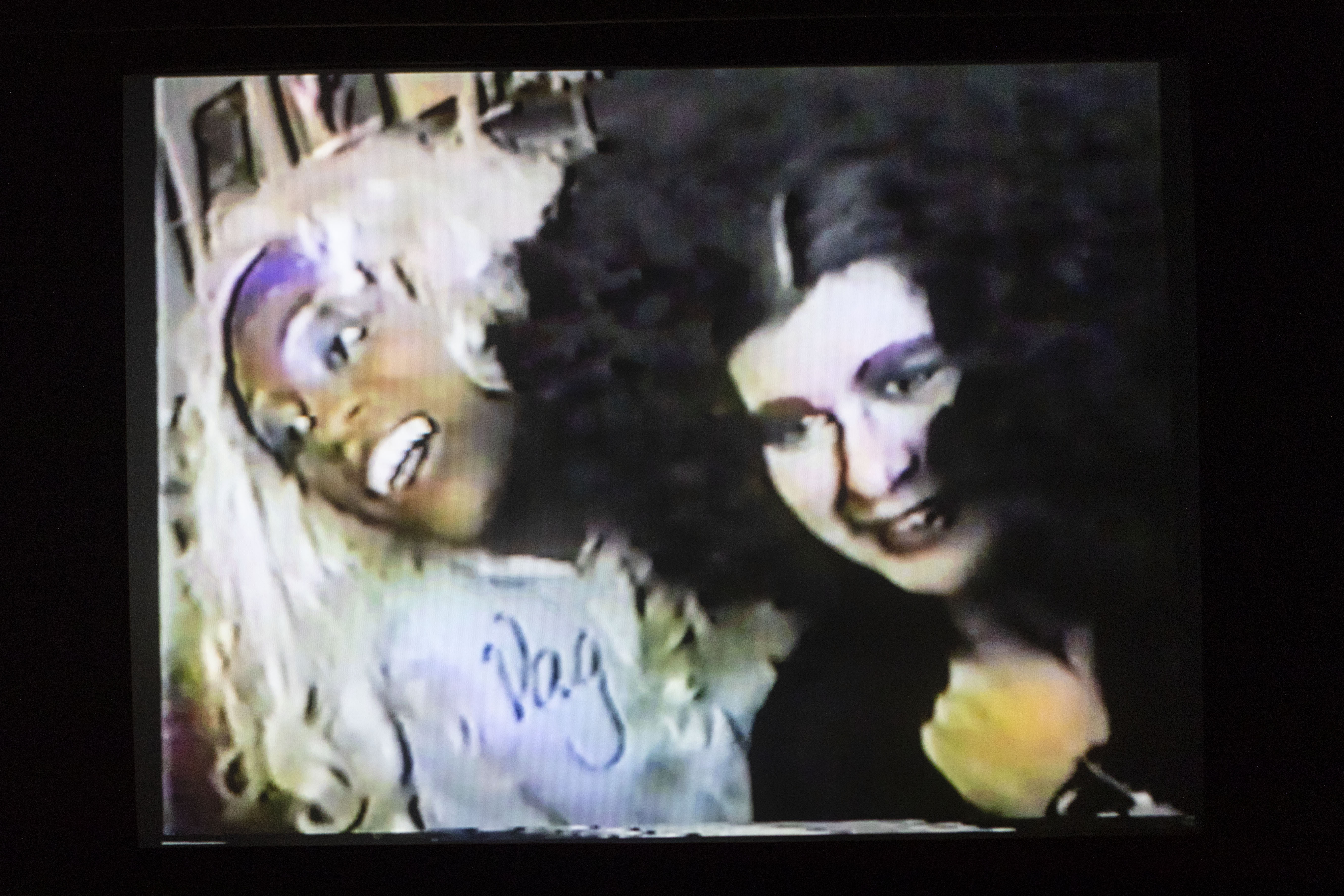
An in-person conversation between Davis and Solveig Nelson, Mellon Postdoctoral Curatorial Fellow and co-curator of The White to Be Angry exhibit, accompanied the screenings. This was the first time in decades Davis had watched some of these films—many of which are collaborative, improvisational scenarios— and they prompted her intimate reminiscing about them, and the DIY spirit that stewarded them into being.
The wildly gyrating camerawork that captured the Cholita! performance and most of Davis’s videos over those several decades is so low budget as to be no budget, but that is what I love about it. It captures perfectly what felt like a wildly free, give no fucks about the quality, care only about the guerilla gesture time to make DIY punk art. It was watching this shoddy camera work as much as it was enjoying what it captured that overwhelmed me with pleasure during that evening’s event. I remember exactly what it felt like, though it was lifetimes ago.
I am 18—a freshman in college. I am opening for Le Tigre—Kathleen Hanna’s early aughts feminist art band so full of joyous, raging fuck you energy that the air whips about me as I dance, smiling hard from our debut. I am a member of Las Sinfronteras—“Without Borders”—a queercore feminist performance art group. I am a Bikini Kill fanatic, a zine maker, a riot grrrl, a scrappy Tucson punk.
Vaginal Davis made all of this possible, birthing all that would coalesce to create the context for the emergence of the 1990s feminist punk riot grrrrl movement that I’ve inherited. Only then could Las Sinfronteras take shape.
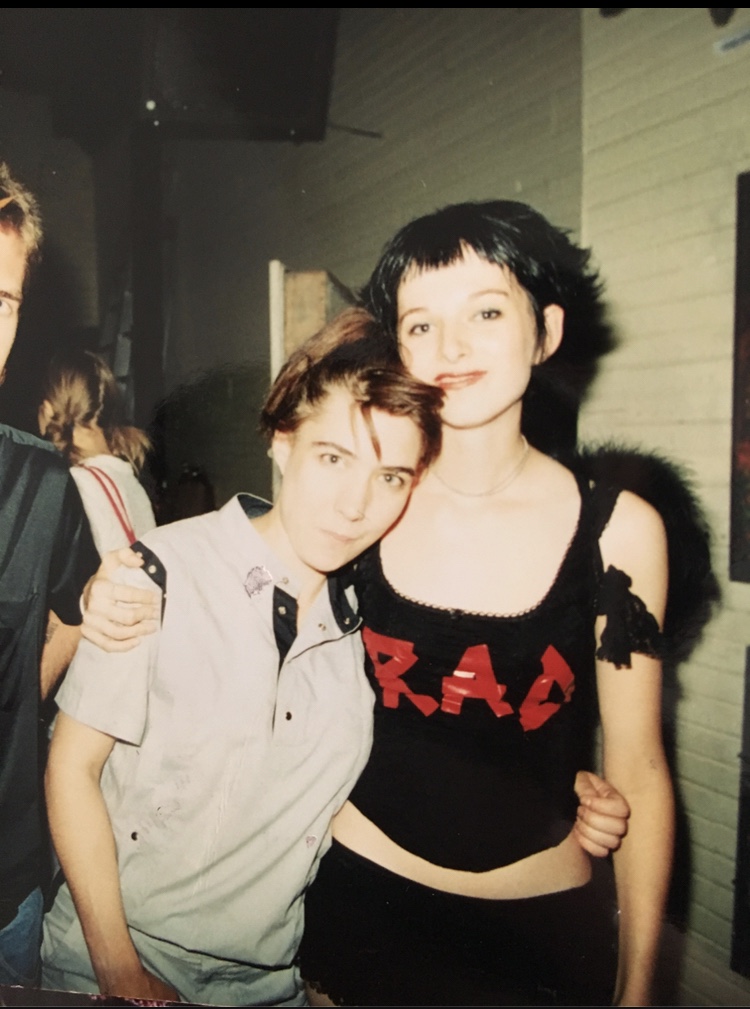
This was the first time we would open for Le Tigre. There would be another time after that, and before that second time there would the time we opened for legendary DC band Fugazi. I look back now, twenty years later, and realize the magnitude of these teenage dreams. But at that time, in 2000, I was just trying to keep on, keep on livin’.
We radical cheerlead in our anarchist drag, sarcastically chanting (“eeny meeny miny mo/to the border here we go/will they let you cross? HELL NO!/why not?/cause you’re from MEXICO!”) then jump into the crowd as Kathleen, JD, and Johanna ascend the stage. I scream the lyrics to “Hot Topic,” bouncing up and down, jostling my neighbors:
So many rules and so much opinion
So much bullshit but we won’t give in
Stop, we won’t stop
Don’t you stop
I can’t live if you stop
Then we collectively shout the ancestral rollcall:
Gertrude Stein, Marlon Riggs, Billie Jean King, Ut, DJ Cuttin Candy, David Wojnarowicz, Melissa York, Nina Simone, Ann Peebles, Tammy Hart, The Slits, Hanin Elias, Hazel Dickens, Cathy Sissler, Shirley Muldowney, Urvashi Vaid, Valie Export, Cathy Opie, James Baldwin, Diane Dimassa, Aretha Franklin, Joan Jett, Mia X, Krystal Wakem, Kara Walker, Justin Bond, Bridget Irish, Juliana Lueking, Cecilia Dougherty, Ariel Skrag, The Need, Vaginal Creme Davis, Alice Gerard, Billy Tipton, Julie Doucet, Yayoi Kusama, Eileen Myles
Oh no no no don’t stop stop
Don’t you stop, Vaginal Davis. Don’t you ever stop. I hope you know what you do to the young people just finding out about you in 2020. The worlds you’ll open up. I heard them talking the night of your “Conversations at the Edge” event (“wow…we could never make those kinds of videos now, could we?”). I saw them flock to you after to ask how. I smiled as I walked out of the room because it is their time.
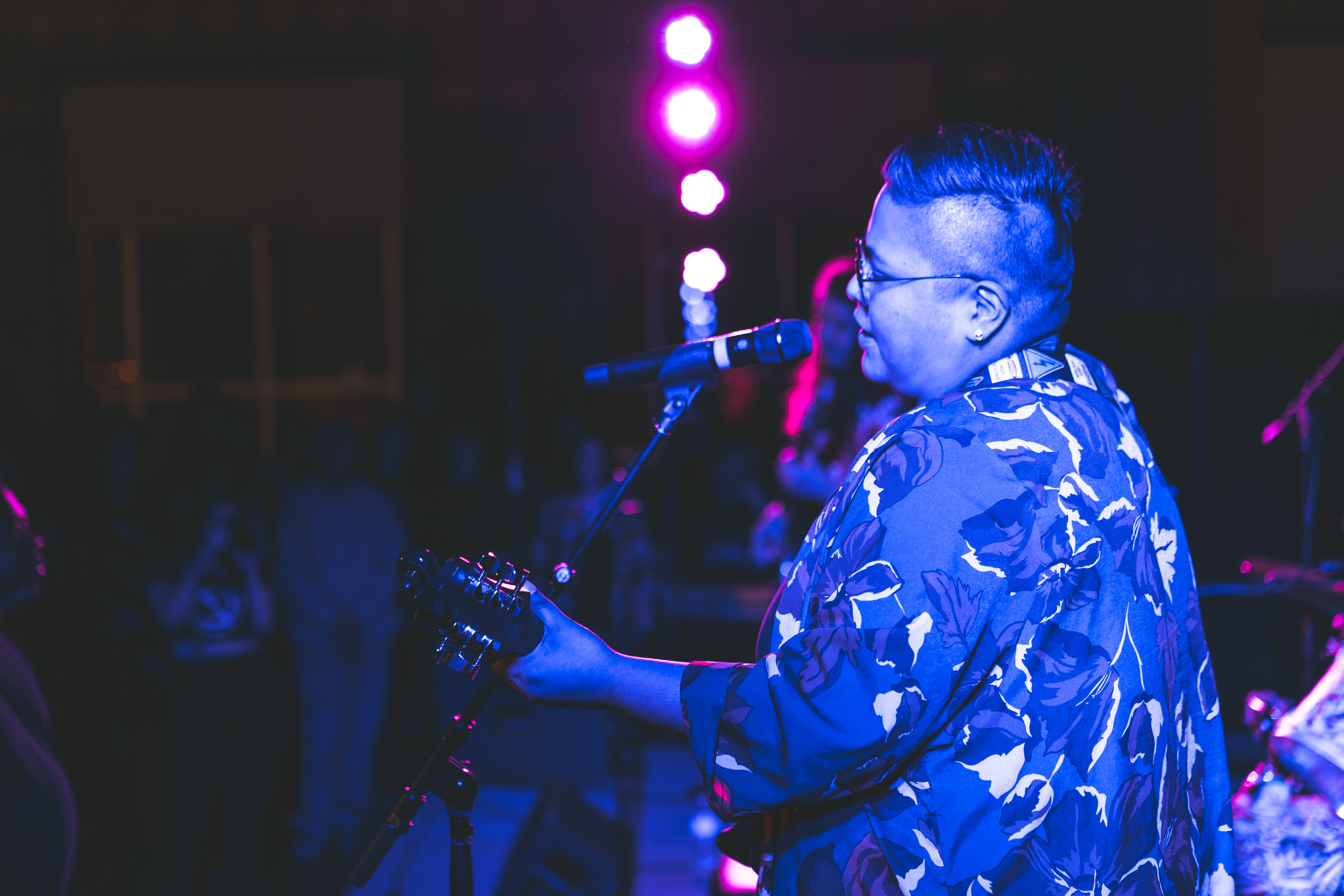
After this I can’t get Davis out of my head. Her energy draws me to another space two weeks later when the AIC hosted a performance in her honor. The BIPOC Punk Takeover show featured mostly Chicago-based Black, Indigenous, and People of Color (BIPOC) punk and hardcore bands including Mermaid N.V., The Breathing Light, and Blacker Face. Organized by Chicago-based collective Black, Brown, and Indigenous Crew, the show served as a contemporary accompaniment to The White to Be Angry. But the BIPOC show also referenced its own local history of Homocore Chicago, a collective founded in the early 1990s. Celebrated for organizing queer punk shows on the regular for about a decade, Homocore Chicago presented diverse artists, including Davis, and helped to make the punk scene less white, less male-dominated, less straight—a legacy that continues today through the Black, Brown, and Indigenous Crew.
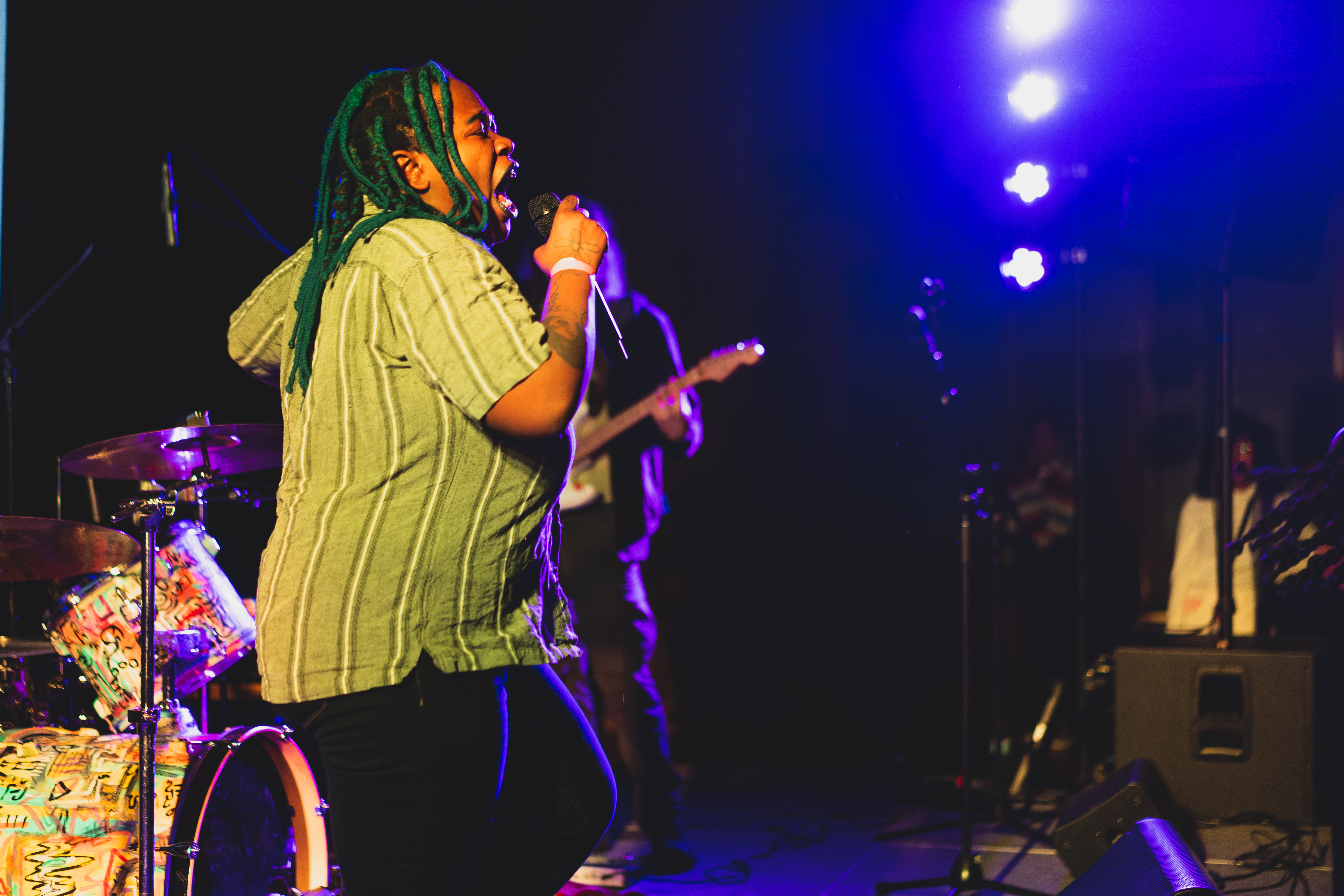
Heeding the call, queer, trans and gender-nonconforming folx of all races and ages filled the beautiful Chicago Stock Exchange Trading Room that late February night. A space perhaps a bit too grand (“how did we get in here!?” one of the members of Mermaid N.V. remarked, laughingly) and a bit too opulent for the occasion, particularly given recurrent critiques throughout the evening about the disenfranchisement of Black and brown people within capitalist labor. We nevertheless had been welcomed (for free! as many proper punk shows used to be) and had come correct, knowing what this evening meant. It was a meeting and melding of institutions (Homocore Chicago as QTPOC underground foundation represented within the venerable AIC) rife with complications and possibilities. What are the risks for marginalized subcultures and people to be granted visibility or “legitimacy” by renowned power structures? Why such inclusion now? Perhaps seeking communion in the face of such questions, we moved as a pack towards the front of the room. A collage of presumably Homocore Chicago-affiliated bands flickered across the backdrop as two MCs took the stage. The evening began with a land acknowledgement, as well as the requisite February shout-out that “every month is Black history month” before they offered a moving tribute to Davis, testifying to the fact that she created her own scene and in so doing, made space for others too often erased, ignored, and relegated to the margins even within so-called “alternative” culture. “BIPOC to the front!” came the rallying cry, and the show began in all its raucous glory.
I am not BIPOC so I stand back, forming the outer layer encircling the revelers in the pit, a kinship formation as familiar to me as my own body. I grew up in the late 1990s hardcore punk scene. On those velvet black desert nights I conceded to the music—violent in its joy, its fury, its knowledge that it was ours—that kept us coming back to the all-ages, community-owned and run club near nightly. I was always in the outer ring watching the boys colliding with abandon until I wasn’t. I was centered once—all the girls were—in pink hockey masks we danced at the core of the circle and they held us in space. Either position, both positions thrilled me. Vaginal Davis’s legacy holds this feeling eternal. Babyqueers, trans, nonbinary, and femme radicals are at the center with her. Irreverent jokester-artists are at the center with her. BIPOC Chicago, Los Angeles, New York is at the center with her. Enter the darkness of Gallery 186 at the AIC and you’re there.
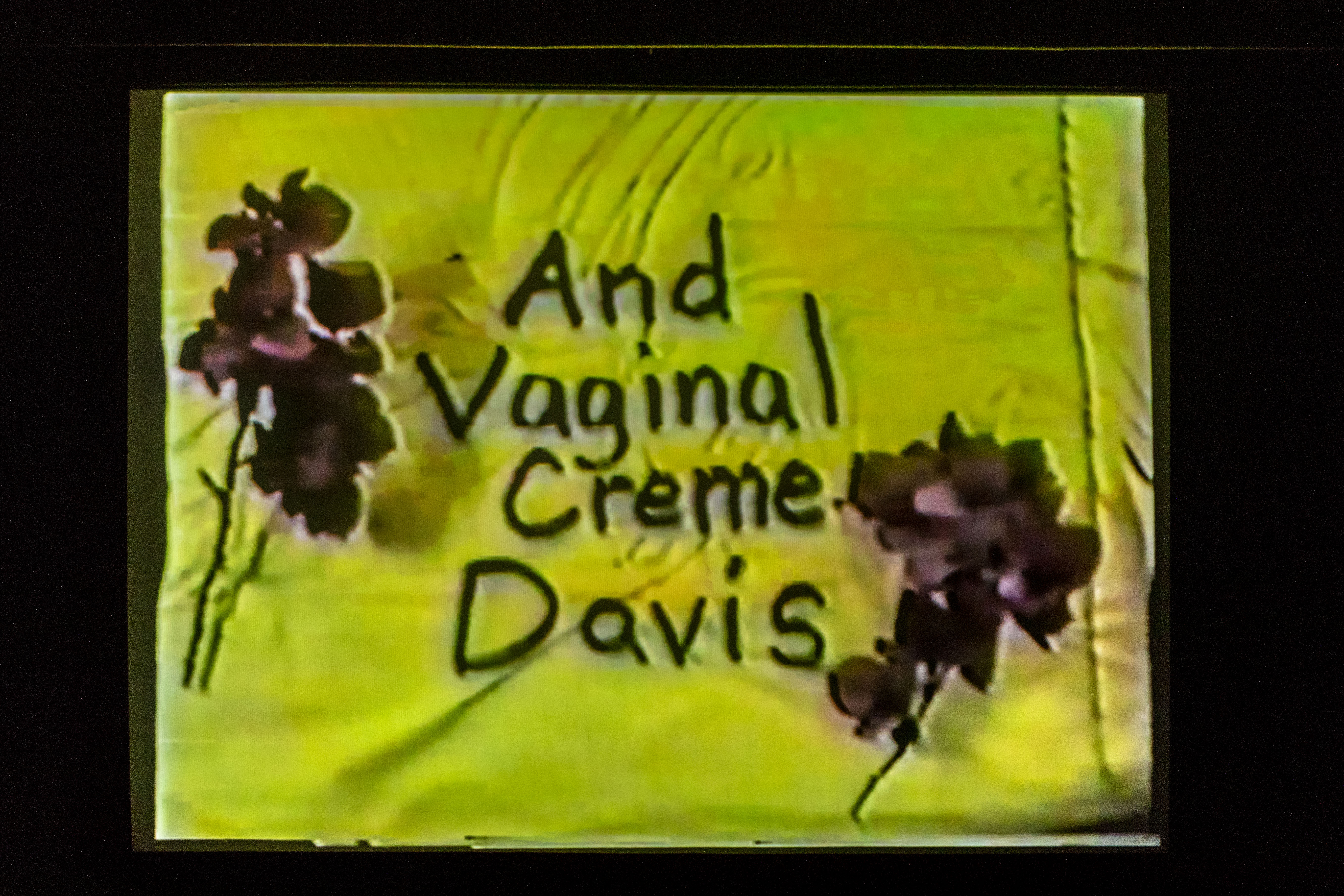
Davis became a prolific independent filmmaker in the early 1980s. The White to be Angry is her touchstone work, a 19-minute visual album she both wrote and directed satirizing (toxic) masculinity, white supremacy, and the unspeakable desires, such as homosexual attraction, underlying and powering these oppressive ideologies. Although its roots lie in giddy 1990s public access excess (as I watch I can’t help but think of John Moritsugu’s 1993 cult film Terminal USA which satirizes some of the same cultural touchstones, particularly the “pervert in the back bedroom” of the American family), its themes remain as germane as ever. Each song is a chapter, and each chapter parodies a famous filmmaker (Woody Allen, Clive Barker, Bruce LaBruce). Interspersed between is collaged television footage. The title of the piece is taken from Davis’s live performances as well as a musical album her band PME recorded in the mid-1990s with legendary Chicago producer Steve Albini. Likewise, the film’s hardcore/speed metal soundtrack is provided by PME.
The White to Be Angry is Davis’s “definitive declaration on race and class in the US of A.” It is an orgy of gleeful depravity; equal parts disturbing, hilarious, and smart. I sat through it four times on a loop, struck each time by some new visual reference. I was particularly taken when, in the final chapter, one of the skinheads is reading Angela Davis. This reminded me of Chicago Pro-Domme Mistress Velvet who requires her white male clients to read Black feminist theory, a resituating of knowledge production that wrests it from the domain of white male privilege and situates it squarely in Black feminist epistemology. Davis herself stars in this chapter as the film director directing her actors in an illicit gay tryst. “You work with me not against me” she instructs one of the skinheads, zooming in closer, and coos in another scene “he looks so good like this! Oh my God he looks great!”, drawing attention to both the carefully constructed performativity of the skinhead’s look, as well as to the unspeakable erotic attraction to fascist aesthetics, the likes of which Susan Sontag wrote of in “Fascinating Fascism” (1974). So much of this film is uncomfortably ambiguous, inciting the viewer of the late 1990s to consider their repressed ideas and desires. Likewise, it presents a challenge to us watching in today’s era of peak wokeness to consider carefully our inclination to cancel anything vaguely offensive.
Vaginal Davis cares little now, as then, for respectability and propriety. She self-admittedly likes to make her audience uncomfortable and if we don’t get the razorsharp critique embedded in the campiness, it really is our loss. “Davis’s political drag”, wrote the late, great queer theorist José Esteban Muñoz, “is about creating an uneasiness in desire, which works to confound and subvert the social fabric.” But as much as her decades of work form this archive of subversion, so too is it a reminder to forge the fabric of collaborative kinship. At the end of her “Conversations at the Edge” event, an audience member asked Davis “what advice would you give a young, queer video and performance artist starting out today? what do you think is necessary for young, queer artists working today to grow a liberated, queer future?” At first Davis replied that she was not sure she is the best person to offer advice because she has always done things in ways that buck tradition. But this is exactly why she is someone we look to.
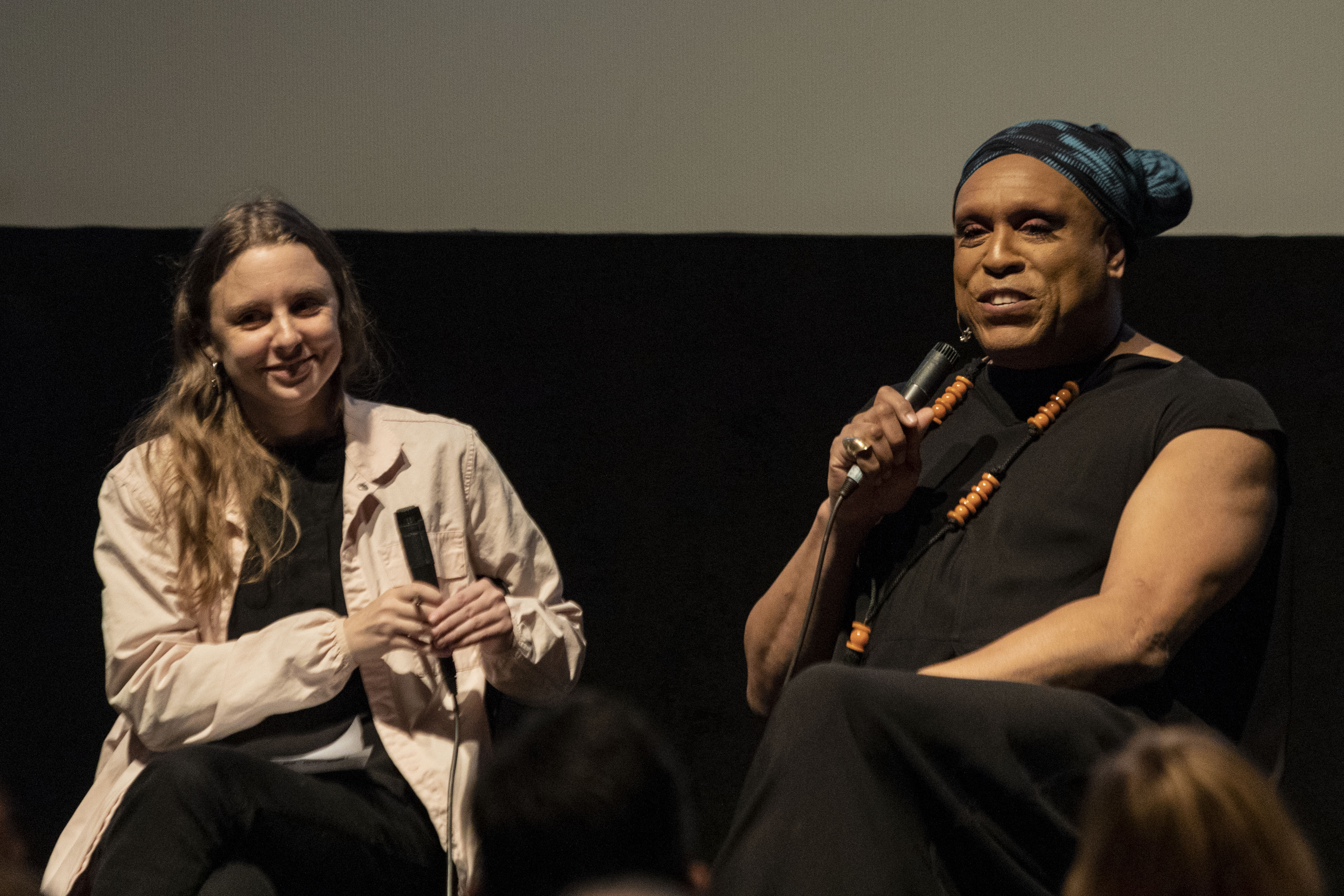
Davis’s work imagines and enacts alternative ways of living. The night of her Siskel screening she reminded us, “I was very angry, just growing up poor in the inner city. But I was always optimistic, too. I didn’t want to just focus on the anger, although that is necessary.” She then shared with us the story of her mother who defied authority to plant community vegetable gardens in inner-city Los Angeles with which she fed all the neighbors. Her mother’s refusal to capitulate to structures of domination, her will to define the contours of her own life, is always with Davis. She has long led the way, showing us how to use biomythography and myriad processes of radical artmaking to propagate care and joie de vivre in an atmosphere of fear and rage and uncertainty. Urging us to “stay close to people who you find connection with, as lifelines, as mentors”, she ended the night offering to be one of those people, committing, in the most generous, genuine manner, to write handwritten letters to those of us who write to her. I just might send her this piece. We have no choice but to continue her legacy, to surprise and shock ourselves into such innovative thrival. We must find, in Davis’s words, “our own mode of production with collaborators and supporters and friends, with people who we trust, and who we love.”
**Editor’s note: Amidst the ongoing coronavirus epidemic, the Art Institute of Chicago is currently closed temporarily. Davis’s exhibition The White to be Angry was scheduled to be on view until April 26th; the museum has indicated that all exhibition dates are subject to change. In the meantime, you can find more information about the exhibition here, and learn more about Davis by visiting her website.
Featured Image: Vaginal Davis (center) performing with Cholita!, one of her underground bands, as seen in video footage from the film Cholita! (1995, directed by Michele Mills). Photo courtesy of the School of the Art Institute of Chicago.


Kirin Wachter-Grene is Assistant Professor of Liberal Arts at the School of the Art Institute of Chicago. She teaches and writes about African American literature and gender and sexuality.